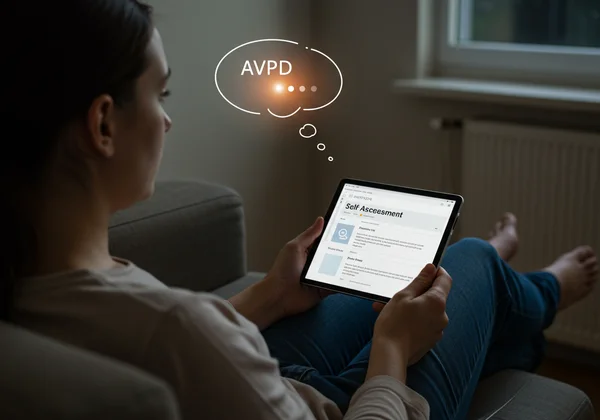Avoidant Personality Disorder (AVPD) Test: Symptoms, Causes & Self-Assessment Guide
Feeling overwhelmed by social situations, constantly fearing criticism, or struggling with deep-seated feelings of inadequacy? You're not alone. This guide offers an empathetic overview of Avoidant Personality Disorder (AVPD) to help you understand its nature, symptoms, and paths toward managing its challenges. Have you ever wondered if your intense social discomfort is more than just shyness? For many, a confidential avpd test is a valuable starting point for self-reflection.
Understanding Avoidant Personality Disorder: What is AVPD?
Avoidant Personality Disorder is a pervasive pattern of social inhibition, feelings of inadequacy, and hypersensitivity to negative evaluation. It's a deeply ingrained pattern of behavior that often begins in early adulthood and is present in a variety of contexts. People with AVPD intensely desire connection but are overwhelmed by the fear of rejection, which leads them to avoid social interactions and relationships, creating a painful cycle of loneliness.

Defining AVPD: More Than Just Shyness
While shyness is a common personality trait, AVPD is a much more severe and debilitating condition. Shyness might make you feel uncomfortable at a party, but you can generally warm up to people. AVPD, on the other hand, involves an all-encompassing fear that can lead to avoiding job opportunities, friendships, and romantic relationships entirely. It’s the difference between feeling nervous before a speech and avoiding any career that might ever require public speaking.
The Core Characteristics of Avoidant Personality Traits
AVPD revolves around a few core characteristics. The first is a profound sense of inadequacy; a belief that you are socially inept, personally unappealing, or inferior to others. This is coupled with a preoccupation with being criticized or rejected in social situations, making even casual interactions feel high-stakes. Finally, this leads to a reluctance to take personal risks or engage in new activities because they may prove embarrassing. These traits combine to form a significant barrier to living a full and connected life.
Recognizing the Signs: Common AVPD Symptoms
Identifying the signs of AVPD is crucial for understanding its impact. These symptoms are not just occasional feelings but persistent patterns that affect your ability to function and form relationships. If you're seeking to understand your own experiences, a preliminary online self-assessment can offer personalized insights.
Emotional and Behavioral Indicators of AVPD
The symptoms of AVPD manifest in both emotional experiences and outward behaviors. Key indicators often include:
-
Avoiding occupational activities that involve significant interpersonal contact due to fears of criticism, disapproval, or rejection.
-
Being unwilling to get involved with people unless certain of being liked.
-
Showing restraint within intimate relationships because of the fear of being shamed or ridiculed.
-
A preoccupation with being criticized or rejected in social situations.
-
Viewing oneself as socially inept, personally unappealing, or inferior to others.
-
An unusual reluctance to take personal risks or to engage in any new activities because they may prove embarrassing.

Social Anxiety vs. AVPD: Unpacking the Differences
It's common to confuse AVPD with Social Anxiety Disorder (SAD), as they share a fear of social situations. However, the core motivation behind the fear is different. A person with SAD is typically afraid of embarrassing themselves or being scrutinized during a specific social performance (like giving a presentation). In contrast, a person with AVPD has a more pervasive negative self-view and fears rejection on a fundamental level, believing they are inherently unworthy of connection. This deep-seated fear of intimacy and rejection is the key differentiator.
Exploring the Roots: What Causes Avoidant Personality Disorder?
There is no single cause of AVPD. Like many mental health conditions, it is believed to stem from a complex interplay of genetic, psychological, and social factors. Understanding these roots is not about placing blame but about fostering compassion for oneself and one's journey.
Genetic Predisposition and Early Life Experiences
Research suggests that a person's temperament, which is partly genetic, can play a role. Infants who are naturally shy, fearful, or inhibited may be more susceptible. However, genetics are only part of the story. Early life experiences, particularly persistent rejection, criticism, or ridicule from parents or peers, can have a profound impact, shaping a core belief that one is flawed and unlovable.
Environmental Factors and Social Triggers of an Avoidant Personality
What triggers an avoidant personality? Often, negative social experiences during formative years can reinforce a child's innate shyness. Bullying, a highly critical home environment, or social humiliation can solidify the fears of rejection that characterize AVPD. The brain learns to see social interaction as a threat, making avoidance a protective, albeit limiting, survival strategy.

Gaining Clarity: Diagnosis & Self-Assessment for AVPD
If this guide resonates with you, you might be wondering about the next steps. Gaining clarity is a two-part process that can involve both professional guidance and personal exploration. A formal diagnosis is a clinical process, but a self-assessment can be an empowering first step.
The Professional Diagnostic Process for AVPD
A definitive diagnosis of Avoidant Personality Disorder can only be made by a qualified mental health professional, such as a psychologist or psychiatrist. The process involves a comprehensive clinical interview where the professional will ask about your long-term patterns of thinking, feeling, and behaving. They will compare your experiences to the criteria outlined in the Diagnostic and Statistical Manual of Mental Disorders (DSM-5) to make an accurate diagnosis. This is the most reliable way to get a complete picture of your mental health.
The Value of an Online AVPD Self-Assessment
Before seeking a professional diagnosis, many people find it helpful to explore their traits in a private, low-pressure environment. This is where an online AVPD test becomes a valuable tool. A good self-assessment, like our online AVPD test, is based on DSM-5 criteria and provides a confidential way to understand your symptoms. It's not a diagnosis, but it serves as an educational starting point, helping you organize your thoughts and decide if seeking professional help is the right next step. Start your assessment to gain initial insights.

Paths to Managing AVPD: Treatment & Coping Strategies
Understanding AVPD is the first step; learning to manage it is the journey toward healing. This path involves both professional support and personal strategies aimed at building confidence and reducing avoidance. Remember, progress is about managing symptoms and improving quality of life, not achieving perfection.
Effective Therapeutic Approaches for AVPD
Therapy is the most effective treatment for AVPD. Cognitive-Behavioral Therapy (CBT) helps individuals identify and challenge the negative thought patterns that fuel their fear of rejection. Other approaches, like psychodynamic therapy, can help explore the root causes of these fears. The goal of therapy is to help you gradually face feared social situations in a safe environment, building social skills and self-esteem along the way.

Building Resilience and Self-Compassion in Daily Life
Alongside professional treatment, you can practice strategies to build resilience. One of the most powerful tools is self-compassion—treating yourself with the same kindness you would offer a friend. This means acknowledging your pain without judgment. Mindfulness can help you stay present with your feelings without being overwhelmed by them. Setting small, achievable social goals, like making eye contact with a cashier, can help you slowly build confidence and challenge the avoidance cycle.
Your Journey to Understanding Avoidant Personality Disorder
Navigating the complexities of Avoidant Personality Disorder is a journey of self-discovery. By understanding its definition, recognizing its symptoms, and exploring its causes, you have already taken a significant step toward empowerment. This understanding brings clarity, helping you see your struggles not as personal failings, but as patterns you can learn to manage.
Your path forward is your own, but it doesn't have to be walked alone. Whether you choose to explore further through self-reflection or decide to seek professional guidance, you are moving toward a more connected and fulfilling life.
Ready to take the first, confidential step on your journey? Start The Free Assessment on our homepage to gain a clearer understanding of your traits in a safe and private setting.
Frequently Asked Questions About Avoidant Personality Disorder (AVPD)
What are the key symptoms of Avoidant Personality Disorder?
The core symptoms include a deep-seated feeling of inadequacy, extreme sensitivity to criticism or rejection, and persistent social inhibition. This leads to avoiding work, school, or social activities that involve other people. A reliable avpd screening tool can help you see how these symptoms relate to your own experience.
How is AVPD different from just being shy or having social anxiety?
Shyness is a personality trait, and social anxiety is a fear of specific social situations. AVPD is a more pervasive personality disorder characterized by a negative self-concept and a deep fear of intimacy and rejection that affects almost every area of life.
How do professionals diagnose Avoidant Personality Disorder?
A mental health professional diagnoses AVPD through a detailed clinical interview, assessing long-term patterns of behavior against the diagnostic criteria in the DSM-5. It is a thorough process that cannot be replaced by an online quiz.
Can I take an online test to see if I have AVPD?
Yes, you can take an online test as a preliminary screening tool. While it is not a formal diagnosis, the free AVPD test on our site is designed to give you confidential and instant insights into potential AVPD traits, helping you decide on your next steps.
What are some initial steps I can take if I suspect I have AVPD?
A great first step is education—reading articles like this one to understand the condition. The next step could be taking a confidential AVPD quiz to gain personal insight. From there, you can consider finding a therapist who specializes in personality disorders to discuss your results and explore treatment options.